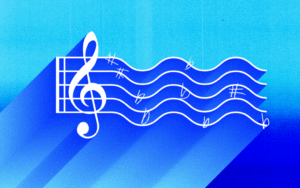NEST Acoustics is a sound design expert, content creator, and plugin developer who’s known for his ability to make Serum come alive.
He’s also known for NEST Academy, his platform that brings production courses, community engagement, and production resources directly to those who are eager to elevate their sound design chops.
In celebration of the release of his Serum Presets Vol. 1 pack, we had the opportunity to sit down with NEST Acoustics for an exclusive interview to get insights into his sound design approach in Serum, perspectives on artistry, and more—read on for highlights.
Explore Serum 2 presets crafted by leading sound designers and producers on Splice.
Serum sound design tips from NEST Acoustics
What do you like most about using Serum?
NEST Acoustics: What I love about Serum is that it has this old-school ’00s software feel of exposing the most ridiculously technical functionality within a user-friendly environment—it’s not simply a raw ‘make-it-yourself’ platform, but it’s also not a hyper-modern streamlined presentation. I halfway expect clippy to pop up to give me hints on what to type into the wavetable math function input bar.
The end result is that it’s insanely fast to get wonderfully characterful sounds, but it’s also fully capable for tweaking and fine-tuning anything you could imagine. It’s creatively lubricated and detail oriented.
What’s the best way for a beginner to start using Serum?
I would say start by pulling the sustain down on Envelope 2 (so it’s not the primary amplitude envelope), and then experiment with modulating anything you can imagine: warp modes, FM amounts, filter settings, wavetable position, pitch, etc.
You don’t necessarily need or want to stack all the modulations at once, but just swap them out or play around with combinations—hearing a nice one-second decay on a parameter allows you to really feel its impact in a dynamic context rather than just turning a knob and hearing it sit still.
Synths come alive when parameters are changing. You almost never just leave something static; it’s the journey from point A to point B that creates the identity and makes you go, “How in the world did this start out as a simple saw or sine wave?”
What are some of the most overlooked or creative ways to use Serum?
In terms of overlooked, using the insert FX version of Serum is so outrageously slept on. If you load Serum FX as a MIDI-controlled effect, you can run your external audio in to cross-modulate with the entirety of Serum—it’s fully MIDI controllable, so we’re talking things like key-tracked comb filters on your snare drum or FM-ing a sine wave via a vocal. Plus, with Serum’s full modulation matrix, the possibilities are endless.
What are some of your favorite Serum presets, made by yourself or others?
Ironically, I’m terrible at remembering my own presets, so it’s almost always easier for me to just sketch a new sound from scratch quickly. The presets I share are in-session sounds that I’ve later refined, polished, and bottled up. It’s nice because almost all of my presets are born out of real-life production sessions, so there’s a real sense of usability.
That said, one preset of mine that I always remember and love is Heartware. I don’t know what happened there, but it just speaks so deeply to me and makes everything sound like a great idea.
NEST Acoustics on artistry and community
You have a very colorful sound as an artist—can you tell us about your influences?
My influences are a broad canopy that I would say are tentpoled by Jónsi (Sigur Rós), M83, and Skrillex. My sonic philosophy is something along the lines of asking myself, “How can I apply the nerdiest bass music sound design techniques in a way that someone like Jim-E Stack would use?”
Your educational programs, presets, and samples are invaluable tools for many creators—what are some of your own favorite tools at the moment?
One of my most enduring obsessions is finding ways to subtly blur the frequency phases of sounds to give them a unique ‘lived in’ texture and non-stagnant impression to the ear.
Pitch / formant-shifting plugins are perfect for this—I’ll throw two of them (they could be the same pitch plugin or two different plugins) in sequence on a channel, and shift them in opposite directions so they cancel out, leaving the instrument harmonically unaffected but with the phase artifacts from the pitch processing. These artifacts are non-linear, so now every new hi-hat, snare, or piano hit will have its transients blurred in a slightly different way, and depending on the plugins used, they’ll give the sustain an almost chorusing feeling.
I just love experimenting with different flavors of artifacts from all sorts of different pitch plugins. It might sound like a minor thing, but it’s so, so subliminally powerful.
As a plugin developer, what are your thoughts around what makes an inspiring product?
My dream products are often this magic combination of being super clear in what they do (so they pop into your head immediately when you hit a situation where you know you need to reach for them), and are easy and rewarding to manipulate, with enough wiggle room to feel like you can infuse your own taste without things feeling too open ended.
A good product also brings something meaningful to the table that’s not gimmicky—although this line is blurry in the production space, because sometimes a gimmicky interface concept can lead you to super inspiring results that you wouldn’t have gotten with another tool that was technically capable of the same thing. But, at least for me, I aim to make tools that feel really creatively inviting and actually do something practical and worthwhile.
Can you share your creative philosophy for what NEST Acoustics aims to offer your community?
I really believe it’s not about me, but about a shared feeling among a slice of humanity, and NEST happened to be the meetup spot. I believe many of us are searching for what making music truly means in this weird era of AI with more tools than ever for anyone to make anything they want, alongside an evolving and sometimes tumultuous vision of what the path for an artist looks like. Ironically, more than ever, we’re searching for our “why” with music.
And the beautiful gift is, we are finding it. It’s a journey I went through myself, where my entire relationship with music was deconstructed, and at the other side, I found a purity and optimism, where the beauty is in the details and the joy is in the time spent with it, not with the results or the data or numbers. And when you bring it back to that primal human resonance, you also inadvertently find the wavelength that resonates in others far more than any contrived or soulless effort will.
Anyway, I think that’s what NEST is all about… It’s truly just an outlet for what I believe in and what stirs my spirit. What it has become is so far beyond my wildest imagination but also feels unbelievably right.
NEST Acoustics’ sounds at your fingertips
We love the Serum preset pack you recently released on Splice—what were your intentions and goals for this pack?
Thank you so much! My journey with Serum and sound design in general has been unconventional in that it admittedly all started from a place of a bit of dissatisfaction. I never viewed myself as a sound designer, but I always had hyper-nuanced opinions on how I wanted things to sound, and I just couldn’t find it anywhere.
With the original Serum in particular, I challenged myself to see if I could make it feel alive and organic in a way that aligned with my personal style, and that led me to a fairly unique approach that felt like a breath of fresh air for me, and I think for others as well.
Is there anything else you’d like to share with the Splice community?
I just want to say Splice and the community around it is such a powerful and beautiful picture of music and creativity. I genuinely believe it’s one of the best models for spreading the wealth while encouraging an updraft of growth and quality I have ever seen, and it truly brings out the best in both the creators and the users. I’m incredibly happy to be able to poke my head in and be a tiny part of what goes on here.
Incorporate NEST Acoustics’ Serum presets into your own productions:
October 23, 2025



